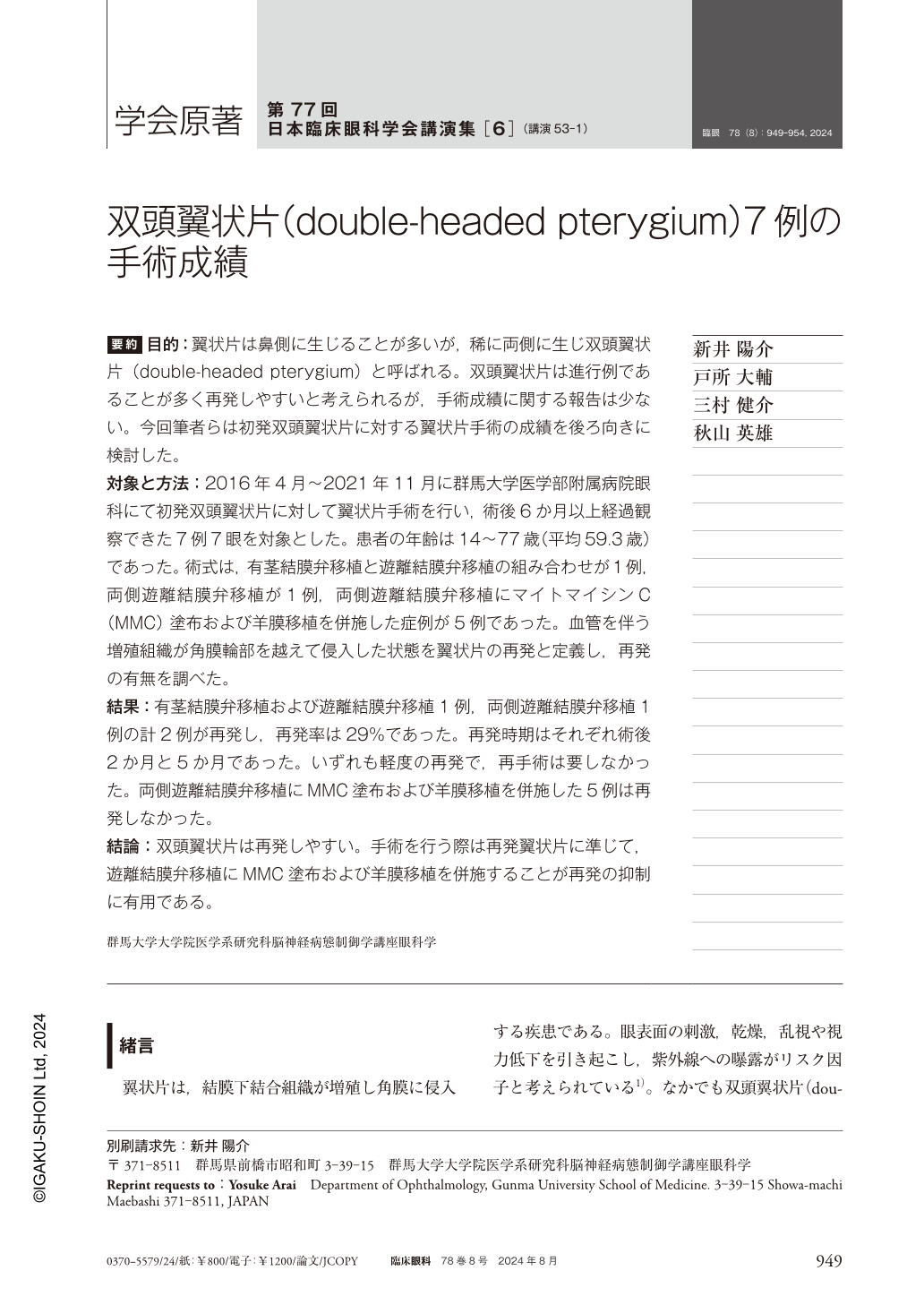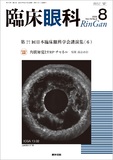Japanese
English
- 有料閲覧
- Abstract 文献概要
- 1ページ目 Look Inside
- 参考文献 Reference
要約 目的:翼状片は鼻側に生じることが多いが,稀に両側に生じ双頭翼状片(double-headed pterygium)と呼ばれる。双頭翼状片は進行例であることが多く再発しやすいと考えられるが,手術成績に関する報告は少ない。今回筆者らは初発双頭翼状片に対する翼状片手術の成績を後ろ向きに検討した。
対象と方法:2016年4月〜2021年11月に群馬大学医学部附属病院眼科にて初発双頭翼状片に対して翼状片手術を行い,術後6か月以上経過観察できた7例7眼を対象とした。患者の年齢は14〜77歳(平均59.3歳)であった。術式は,有茎結膜弁移植と遊離結膜弁移植の組み合わせが1例,両側遊離結膜弁移植が1例,両側遊離結膜弁移植にマイトマイシンC(MMC)塗布および羊膜移植を併施した症例が5例であった。血管を伴う増殖組織が角膜輪部を越えて侵入した状態を翼状片の再発と定義し,再発の有無を調べた。
結果:有茎結膜弁移植および遊離結膜弁移植1例,両側遊離結膜弁移植1例の計2例が再発し,再発率は29%であった。再発時期はそれぞれ術後2か月と5か月であった。いずれも軽度の再発で,再手術は要しなかった。両側遊離結膜弁移植にMMC塗布および羊膜移植を併施した5例は再発しなかった。
結論:双頭翼状片は再発しやすい。手術を行う際は再発翼状片に準じて,遊離結膜弁移植にMMC塗布および羊膜移植を併施することが再発の抑制に有用である。
Abstract Purpose:Pterygium often occurs on the nasal side, but rarely occurs on both sides, which is called double-headed pterygium. Although double-headed pterygium is often advanced and prone to recurrence, there are few reports on its surgical outcomes. Here we retrospectively investigated the surgical outcomes of pterygium excision.
Subjects and methods:Seven patients(7 eyes)who underwent pterygium the excision of primary double-headed pterygium at Gunma University Hospital between January 2016 and April 2021 and completed more than 6 months of follow-up were enrolled. The patients were 14 to 77 years of age(mean' 59.3 years). The surgical methods included a combination of rotated conjunctival autograft transplantation and free conjunctival autograft transplantation(1 case), bilateral free conjunctival autograft transplantation(1 case), and bilateral free conjunctival autograft transplantation along with intraoperative mitomycin C(MMC)application and amniotic membrane transplantation(5 cases). The rate of pterygium recurrence' defined as the invasion of proliferative tissue with blood vessels beyond the limbus, was investigated.
Results:A total of 2 patients(29%)experienced recurrence:1 with a combination of rotated conjunctival autograft transplantation and free conjunctival autograft transplantation, and 1 with bilateral free conjunctival autograft transplantation. The recurrence times were 2 and 5 months after surgery. All cases of recurrences were mild, and none required reoperation. No recurrence occurred in the 5 cases treated with bilateral free conjunctival flap transplantation combined with MMC and amniotic membrane transplantation.
Conclusion:Double-headed pterygium is prone to recurrence. To suppress its recurrence, the use of free conjunctival flap transplantation in combination with MMC application and amniotic membrane transplantation is advised.

Copyright © 2024, Igaku-Shoin Ltd. All rights reserved.


